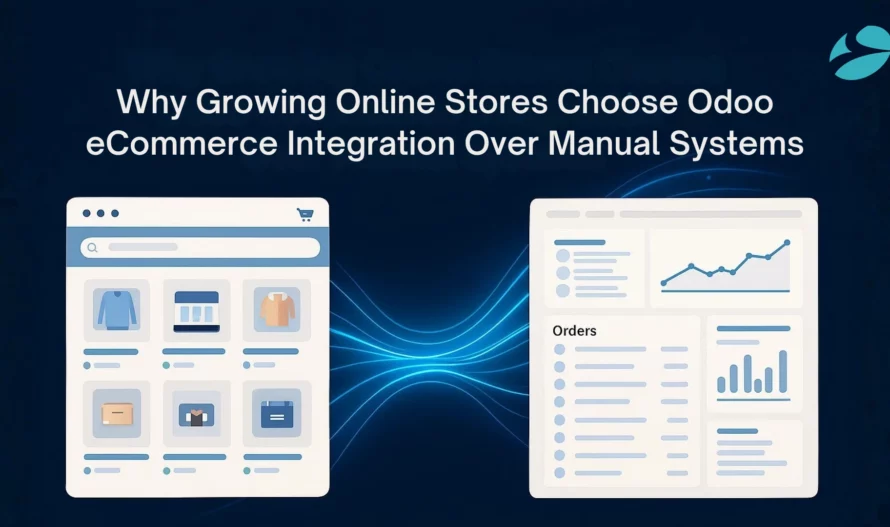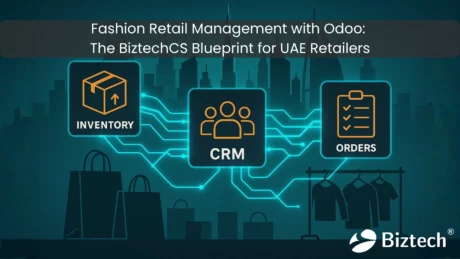149
Why Growing Online Stores Choose Odoo eCommerce Integration Over Manual Systems
16 May, 2025
5 min read
149
16 May, 2025
5 min read

Most online stores hit the same problem around month six or seven. You’re doing decent sales, but suddenly you’re drowning in spreadsheets. Inventory’s wrong half the time. Orders are getting mixed up. Your accountant keeps asking for files that should’ve been automated months ago.
The present landscape demands a connected ecosystem that enhances the online store’s operations. Having a digital system that responds instantly to customer behavior, provides real-time inventory status, and adapts to fluctuating market demands is essential.
What the store needs is an established communication system between multiple systems. With that in place, you will not have to worry about overselling products, sending wrong items, or spending hours and hours filling Excel sheets.
This is where Odoo eCommerce integration comes into the picture. It creates a complete ecosystem that eliminates the maze of spreadsheets, disconnected tools, and slow manual updates.
Well, the issue is that most retailers use a separate system for their website, another one for inventory, and another for accounting, while using Slack or email as duct tape to connect them all.
What happens? Order comes in at 2 PM. Inventory doesn’t update until the end of the day. Warehouse is working off the morning’s pick list. The accounting department gets a CSV file on Friday afternoon. Customer service is guessing based on whatever they can see.
Nothing is being communicated on time, causing delays and mismanagement, which in turn impacts customer service. The bottleneck isn’t people working harder. Its systems are not sharing information.
And, in a world where consistency is the key defining point, misaligned processes can translate into a lack of commitment. It will hinder business growth in more ways than one. Customer will not come again if services do not meet their expectations. Investment will turn into stuck capital that could’ve been used for business growth.
Odoo’s built modular. Start with inventory and accounting if that’s what’s broken. Add CRM later when you need it. Marketing automation implementation when needed for the business. You’re not forced into buying everything up front.
Some of the key features for an eCommerce business include:
That last point matters more than it sounds. Real-time means when something sells, your stock count drops immediately across all channels. This way, you won’t oversell any product. Odoo eCommerce integration makes this possible, making it a necessary investment rather than a choice.
Consider a mid-sized retailer running Shopify for their storefront and Tally for accounting. Works fine for the UAE market. Then they expand to Saudi Arabia.
Suddenly, they’re dealing with:
Manual reconciliation between Shopify and Tally becomes impossible. They start overselling because the inventory sync lags by hours. Returns aren’t feeding back into financial reports properly. The accounting team is drowning.
After implementing Odoo eCommerce integration, Shopify data flows directly into Odoo. Orders, inventory, and customer records all sync automatically. Finance sees real-time data. Warehouse operates off current stock levels, not yesterday’s count. Customers get accurate delivery estimates.
Within 90 days: refund requests drop 37%, order accuracy hits 98%. Not because people started working harder, but because systems started working together.
Odoo integration connects backend processes so seamlessly that the system almost becomes invisible behind automation. Here’s how Odoo achieves that:
Order hits your store → appears in Odoo instantly and triggers the inventory deduction, invoice creation, warehouse picks order generation, everything is automated.
Stock sells anywhere (online, in-store, wholesale) → updates everywhere simultaneously. Multi-channel inventory management without manual adjustments.
Customer data centralizes → purchase history, support tickets, contact info in one place. Marketing can segment based on actual behavior instead of guessing.
Accounting happens → sales transactions flow directly into books. No end-of-week CSV imports or reconciliation marathons.
Shipping tracking updates → customers see real-time order status without your team manually updating anything.
This is Odoo eCommerce integration, removing manual steps that eat up 20+ hours weekly.
The market is filled with multiple options for developing an eCommerce platform, and Odoo integration practices and extent vary with every platform. For example:
This is ideal for D2C brands with high-volume transactions. In this case, Shopify handles the storefront, Odoo manages order fulfillment, accounts receivable, and customer relationships.
Perfect for businesses that are already using WordPress. WooCommerce data gets automatically synced with Odoo, including product catalogues and taxes, allowing for prompt inventory updates without delays or plugin chaos.
Perfect for enterprise-grade eCommerce businesses. It manages an extensive product database and synchronizes data from multiple warehouses with Odoo’s backend modules to streamline complex interconnected systems.
Each setup gets customized based on geography and compliance needs. Saudi operations need ZATCA e-invoicing from day one. European setups prioritize GDPR handling. Indian businesses need GST automation built in.
Odoo eCommerce integration allows extensive flexibility. It adapts to your market requirements, business constraints, and streamlines processes instead of adding to the complexity.
Before integration: Website orders go to one team. The rest of the operations, including fulfillment, accounting, inventory data log, and marketing, are managed by their own respective teams. The systems that should work in an interconnected manner are functioning separately. Everyone’s busy and overburdened, yet the desired results are far from reach.
After integration: Orders flow into Odoo immediately. All teams work off identical real-time data. Reports generate automatically—sales trends, margins, fulfillment rates. Customer service pulls complete order histories in under 10 seconds, eliminating the need to call three departments.
This efficiency comes from integrated systems that communicate information instead of isolating processes. A retail business can reduce stockouts by 92% with Odoo integration and decrease delivery time by almost 60%.
The key thing to understand is that this is not even process optimization; this is Odoo simply connecting the broken chords.
Once systems connect, you can do things that weren’t possible before.
Identify top SKUs by region from actual sales data. Forecast demand using historical patterns instead of gut feeling. Personalize offers based on purchase behavior. When eCommerce data, ERP, and BI are integrated into one system, you stop reacting and start predicting.
For instance, A GCC electronics retailer integrated a CRM and email marketing post-eCommerce connection. These automated campaigns are triggered by multiple events, such as purchases, birthday discounts, restock alerts, and product recommendations. It improved engagement and brand visibility, which increased reported orders by 25%.
That’s the multiplier effect. One integration enables other capabilities that weren’t feasible before.
Odoo handles localization natively:
These aren’t add-ons you bolt on later. They’re built into modules, so Odoo eCommerce integration stays compliant from deployment.
At BiztechCS, we don’t recommend integrating everything simultaneously.
Start with eCommerce + Inventory + Accounting. Get that stable. Measure results. Then add CRM. Then marketing automation. Then, advanced warehouse management. Build it incrementally.
This minimizes disruption and lets you measure ROI at each phase instead of one massive all-or-nothing implementation.
One of our consultants summarizes it: “Build your Odoo ecosystem like infrastructure—one solid piece at a time, testing each before adding the next.”
When your integration roadmap matches business milestones, growth becomes sustainable rather than chaotic. Here’s how Odoo eCommerce integration showcases the differences in the form of key assessment metrics:
|
Metric |
Before |
After |
|
Order Accuracy |
85% |
98% |
|
Refunds from Stock Errors |
14% |
3% |
|
Manual Data Entry |
25 hrs/week |
<3 hrs/week |
|
Customer Response Time |
2 days |
4 hours |
|
Inventory Turnover |
Sluggish |
Real-time optimized |
These improvements show up across operations—logistics, accounting, and customer satisfaction. The kind that affects the bottom line, not just internal processes.
Integration isn’t the endpoint. As eCommerce and physical retail converge, Odoo’s omnichannel capabilities matter more.
POS systems update the central inventory instantly when in-store sales happen. Marketing sees customer journeys across online and offline. CFOs are viewing consolidated financials across countries without waiting for month-end reports.
That’s where Odoo eCommerce Integration is heading—ecosystems that adapt and grow with your business instead of requiring constant manual intervention.
Online stores are everywhere. What separates thriving businesses from struggling ones isn’t traffic or marketing budget—it’s operational efficiency.
Odoo provides efficiency, but implementation determines success.
BiztechCS works with eCommerce businesses across the UAE, Saudi Arabia, India, Europe, and North America on Odoo integrations that fit specific operational requirements. We handle discovery through rollout, ensuring integration fits your business instead of forcing your business to fit the system.
Want to see how Odoo integration will transform your eCommerce business? Tell us your expectations, and we will transform them into growth opportunities powered by Odoo.

Artificial Intelligence (AI)
65
By Afzal Qureshi
05 Dec, 2025

Artificial Intelligence (AI)
73
By Afzal Qureshi
04 Dec, 2025

Odoo
449
By Uttam Jain
03 Dec, 2025